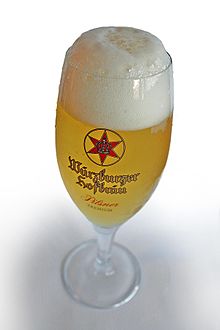Pale lager: Difference between revisions
Why was this reverted? The link works fine. |
|||
| Line 129: | Line 129: | ||
*Darryl Richman, ''Bock (Classic Beer Style)'', Brewers Publications, 1994, ISBN 093738139X |
*Darryl Richman, ''Bock (Classic Beer Style)'', Brewers Publications, 1994, ISBN 093738139X |
||
===External links=== |
===External links=== |
||
*[http://www.europeanbeerguide.net/lager19.htm European Beer Guide Lager history] |
|||
*[http://www.bjcp.org/2008styles/style01.php BJCP Light Lager Guidelines] |
*[http://www.bjcp.org/2008styles/style01.php BJCP Light Lager Guidelines] |
||
Revision as of 01:48, 9 February 2009

Pale lager is a very pale to golden-coloured beer with a well attenuated body and noble hop bitterness. The brewing process for this beer developed in the mid 19th century when Gabriel Sedlmayr took pale ale brewing techniques back to the Spaten Brewery in Germany and applied it to existing lagering brewing methods. This approach was picked up by other brewers, most notably Josef Groll who produced Pilsner Urquell. The resulting pale coloured, lean and stable beers were very successful and gradually spread around the globe to become the most common form of beer consumed in the world today, and includes the American beer Budweiser, the world's highest volume selling beer.
The main elements of the lagering method used by Sedlmayr and Groll are still used today, and depend on a slow acting yeast that ferments at a low temperature while being stored. Indeed, the German term '[Lager] Error: {{Lang}}: text has italic markup (help)' means 'storage'. While first marketed as '[Lagerbier] Error: {{Lang}}: text has italic markup (help)' in Austria and Germany, the term is now quite uncommon in the German speaking countries where today one would simply ask for '[helles Bier] Error: {{Lang}}: text has italic markup (help)' (pale lager), '[dunkles Bier] Error: {{Lang}}: text has italic markup (help)' (dark lager or ale) or specific varieties, particularly those with a distinctive character such as Pilsner or Weizenbier (also called [Weissbier] Error: {{Lang}}: text has italic markup (help)). In the English speaking world, however, lager is now a general name for any beer made using the lagering method.
History
Bavarian brewers in the sixteenth century were required by law to brew beer only during the cooler months of the year. In order to have beer available during the hot summer months, beers would be stored in caves and stone cellars, often under blocks of ice.
In the period 1820-1830, a brewer named Gabriel Sedlmayr II the Younger, whose family was running the Spaten Brewery in Bavaria went around Europe to improve his brewing skills. When he returned, he used what he had learned to get a more stable and consistent lager beer. The Bavarian lager was still different from the widely-known modern lager; due to the use of dark malts it was quite dark, representing what is now called Dunkel beer or the stronger variety, Bock beer.
The new recipe of the improved lager beer spread quickly over Europe. In particular Sedlmayr's friend Anton Dreher used the new lagering technique to improve the Viennese beer in 1840–1841, creating Vienna lager. New kilning techniques enabled the use of lighter malts, giving the beer an amber-red rich colour.
Description
Pale lagers tend to be dry, lean, clean-tasting and crisp (due to acidity from the forced carbonation). Flavours may be subtle, with no traditional beer ingredient dominating the others. Hop character (bitterness, flavour, and aroma) ranges from negligible to a dry bitterness from noble hops. The main ingredients are water, Pilsener malt and noble hops, though some brewers use adjuncts such as rice or corn to lighten the body of the beer. There tends to be no butterscotch flavour from diacetyl, due to the slow, cold fermentation process.
Variations
Pale lager was developed in the mid 19th century when Gabriel Sedlmayr took some British pale ale brewing techniques back to the Spaten Brewery in Germany, and started to modernise continental brewing methods. In 1842 Josef Groll of Pilsen, a city in western Bohemia in what is now the Czech Republic, used some of these methods to produce Pilsner Urquell, the first known example of a golden lager.[1] This beer proved so successful that other breweries followed the trend, using the name Pilsner. Breweries now use the terms "lager" and "Pilsner" interchangeably, though pale lagers from Germany and the Czech Republic with the name Pilsner tend to have more evident noble hop aroma and dry finish than other pale lagers.[2][3]
With the success of Pilsen's golden beer, the town of Dortmund in Germany started brewing pale lager in 1873. As Dortmund was a major brewing centre, and the town breweries grouped together to export the beer beyond the town, the brand name Dortmunder Export became known.[4] Today, breweries in Denmark, the Netherlands, and North America brew pale lagers labeled as Dortmunder Export.

A little later, in 1894, the Spaten Brewery in Munich recognised the success of these golden lagers and utilised the methods that Sedlmayr had brought home over 50 years earlier to produce their own light lager they named Helles, which is German for 'light coloured', 'bright' or, in beer terms, 'pale',[5][6] in order to distinguish it from Dunkelbier or dunkles Bier (dark beer), which is another type of beer typical for the region, being darker in colour and sweeter than Helles.
Examples of Helles include, Löwenbräu Original, Spaten Premium Lager, Weihenstephaner Original Bayrisch Mild, Hofbräu München Original, Augustiner Bräu Lagerbier Hell, and Hacker-Pschorr Münchner Helles.
The earliest known brewing of pale lager in America was in the Old City section of Philadelphia by John Wagner in 1840 using yeast from his native Bavaria. Modern American-style lagers are usually made by large breweries such as Anheuser-Busch. Lightness of body is a cardinal virtue, both by design, and since it allows the use of a high percentage of rice or corn. Indeed, light versions of American lagers are very popular in the United States, lower in food energy and even lighter in body and taste. Prominent examples include Budweiser, Miller High Life, Coors, and Molson Golden, which is Canadian.
Though all lagers are well attenuated, a more fully attenuated pale lager in Germany goes by the name Diet Pils.[7] A marketing term for a fully attenuated pale lager, originally used in Japan by Asahi Breweries in 1987, "karakuchi" or "dry", [8] was taken up by the American brewer Anheuser-Busch in 1988 as "dry beer" for the Michelob brand, Michelob Dry.[9] This was followed by other "dry beer" brands such as Bud Dry, though the marketing concept was not considered a success.[10] In fully attenuated pale lagers, nearly all the sugar is converted to alcohol due to the long fermentation period. The resulting clean, lean flavour is referred to as "dry".[11]
Premium lager
Premium lager is a marketing term sometimes used by brewers for products they wish to promote; there is no legal definition for such a product, but it is usually applied to an all malt product of around 5% abv. Anheuser-Busch also uses the terms "sub-premium" and "super-premium" to describe the low-end Busch beer and the high-end Michelob.
Some beers marketed as premium are: Stella Artois,[12] Tuborg,[13] and Peroni.[14]
Spezial is a stronger style of pale lager, mostly brewed in Southern Germany, but also found in Austria and Switzerland. Spezial slots in between Helles and Bock in terms of flavour characteristics and strength. Full-bodied and bittersweet, it is delicately spiced with German aroma hops. It has a gravity of between 12.5° and 13.5° Plato and an alcohol content of 5.5 - 5.8% abv. The style has been in slow decline over the last 30 years, but still accounts for around 10% of beer sales in Bavaria.
Strong lager
Pale lagers that exceed an abv of around 5.8% are variously termed Bock, malt liquor, super strength lager, Oktoberfestbier/Märzen, or European strong lager.
Bock
Bock is a strong lager which has origins in the Hanseatic town Einbeck, Germany. The name is a corruption of the medieval German brewing town of Einbeck, but also means goat (buck) in German. The original bocks were dark beers, brewed from high-coloured malts. Modern bocks can be dark, amber or pale in colour. Bock was traditionally brewed for special occasions, often religious festivals such as Christmas, Easter or Lent.
Malt liquor
Malt liquor is an American term referring to a strong pale lager. In the UK, similarly-made beverages are called super-strength lager.
Oktoberfestbier / Märzen
Oktoberfest is a German festival dating from 1810, and Oktoberfestbiers are the beers that have been served at the event in Munich since 1818, and are supplied by 6 breweries known as the Big Six: Spaten, Löwenbräu, Augustiner-Bräu, Hofbräu-München, Paulaner and Hacker-Pschorr.[15] Traditionally Oktoberfestbiers were the lagers of around 5.5 to 6% abv called Märzen - brewed in March and allowed to ferment slowly during the summer months.[16] Originally these would have been dark lagers, but from 1872 a strong March brewed version of an amber-red Vienna lager made by Josef Sedlmayr became the favourite Oktoberfestbier. Since the 1970s the type of beer served at the festival has been a pale lager between 5 and 6% abv, and the terms Oktoberfest and Märzen are used by non-Oktoberfest brewers in Germany and the USA to market pale lagers of this strength.[17] The colour of these lagers may range from pale gold to deep amber, with the darker colours more common in the USA. Hop levels tend not to be distinctive, though some USA examples may be firmly hopped. Modern beers sold as Oktoberfest and Märzen in Europe tend not to be too differentiated from other pale lagers of this strength, while older German, USA and USA influenced examples will be fairly malty in flavour and inclined to use a range of malts especially dark malts such as Vienna or Munich. [18]
References
Notes
- ^ Michael Jackson's Beer Hunter - The birth of lager
- ^ Michael Jackson's Beer Hunter - Beer Styles: Pilsener/Pilsner/Pils
- ^ beer-pages.com - Roger Protz Complete Guide to World Beer
- ^ beer-pages.com - all you need to know about beer
- ^ Helles
- ^ German Beer Guide: Münchner Helles
- ^ Michael Jackson's Beer Hunter - Beer Styles: Diat Pils
- ^ Asahi Breweries | Products | Asahi Super Dry
- ^ Philip Van Munching, Beer Blast, pp 232-233, 1997, ISBN 0-8129-6391-1
- ^ Philip Van Munching, Beer Blast, pp 233-235, 1997, ISBN 0-8129-6391-1
- ^ Michael Jackson's Beer Hunter - Beer Styles: Dry Beer
- ^ "Marketing News: Stella and Carlsberg clash over 'UK's best beer' claims - Marketing Week". www.marketingweek.co.uk. Retrieved 2008-05-06.
- ^ "Tuborg to sponsor Reading and Leeds festivals - Morning Advertiser". www.morningadvertiser.co.uk. Retrieved 2008-05-06.
- ^ "SAB to launch Peroni in Russia - Drinks International Magazine". www.drinksint.com. Retrieved 2008-05-06.
- ^ "Big Six Breweries in Munich". www.beerdrinkersguide.com. Retrieved 2008-05-04.
- ^ "Food from Bavaria - Regionaltypische Spezialität". www.food-from-bavaria.de. Retrieved 2008-05-04.
- ^ "Michael Jackson's Beer Hunter - The birth of lager". www.beerhunter.com. Retrieved 2008-05-04.
- ^ "BJCP 2008 Style Guidelines - Category 03". www.bjcp.org. Retrieved 2008-05-04.
Bibliography
- George J. Fix, Vienna Marzen Oktoberfest (Classic Beer Style), Brewers Publications, 1991, ISBN 0937381276
- David Miller, Continental Pilsener (Classic Beer Style), Brewers Publications, 1990, ISBN 0937381209
- Darryl Richman, Bock (Classic Beer Style), Brewers Publications, 1994, ISBN 093738139X
